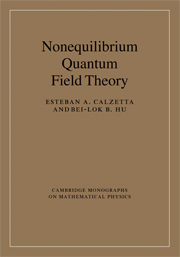Book contents
Preface
Summary
In the last decade or two we see increasing research activities in areas where quantum field processes of nonequilibrium many-body systems prevail. This includes nuclear particle physics in the relativistic heavy ion collision (RHIC) experiments, early universe cosmology in the wake of high-precision observations (such as WMAP), cold atom (such as Bose–Einstein) condensation (BEC) physics in highly controllable environments, quantum mesoscopic processes and collective phenomena in condensed matter systems. There is a demand for a new set of tools and concepts from quantum field theory to treat the nonequilibrium dynamics of relativistic many-particle systems and for the understanding of basic issues like dissipation, entropy, fluctuations, noise and decoherence in these systems.
The subject matter of this book is at the intersection of nonequilibrium statistical mechanics (NEqSM) and quantum field theory (QFT). It deals with the nonequilibrium quantum processes of relativistic many-body systems with techniques from quantum field theory. To a lesser extent it also touches on the nonequilibrium statistical mechanical aspects of interacting quantum field theory itself. This subject matter is a natural extension of thermal field theory from equilibrium (finite temperature) to nonequilibrium systems. One major technical challenge is that the usual Euclidean or imaginary time quantum field theoretical methods applicable to stationary quantum systems are no longer valid (except for linear response in near-equilibrium conditions) and real-time formulations are required.
The book has five parts: The first part comprising Chapters 1-3 deals with the basics.
- Type
- Chapter
- Information
- Nonequilibrium Quantum Field Theory , pp. xiii - xviPublisher: Cambridge University PressPrint publication year: 2008

